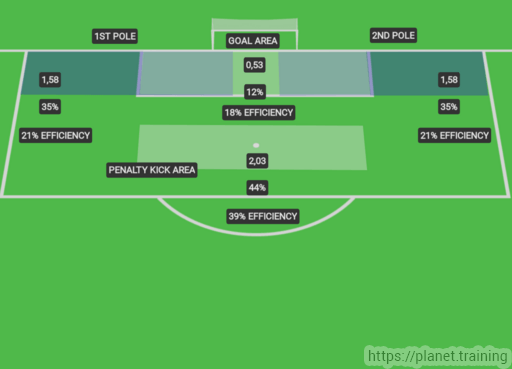WORLD CLASS COACHING
Tactical Series Pep Guardiola
By Luca Bertolini
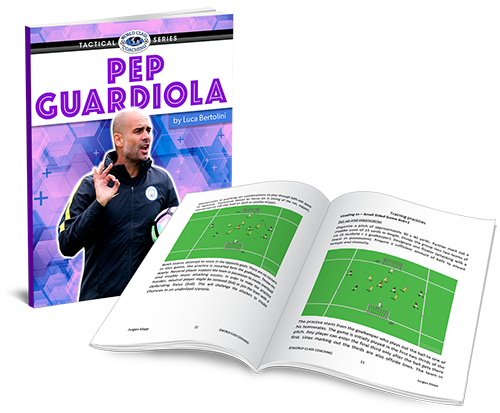
Table of Contents
PART ONE
Introduction
Manchester City's Possession Phase Stats
PART TWO
Guardiola's New Way of Attacking and Possession on the Flanks
The Development of Positional Play Games
The Importance of Half Spaces
PART THREE
A Complete Possession Phase
Transition to Defend
PART FOUR
Defending Phase
Transition to Attack and Counter Attacks.
INTRODUCTION
The principles of play of Pep Guardiola's Manchester City
“Success without playing the way you like to play means nothing to me.”
"I will win and I will lose, but I will go on attacking with 10 players.”
These are two of the philosophical principles of Pep Guardiola's soccer, maybe the most important and representative.
Manchester City is not the same team of the two time Champions League winner (2009 - 2011) Barcelona, as it plays with very wide wingers, with inverted fullbacks, and with players like David Silva, De Bruyne or Gundogan, who are very good at cutting the ball from the back to finish. The common points are surely the building up from the back phase of play through the goalkeeper, the wide center backs and the balance player (City's Busquets is Fernandinho).
Some details clarify the basic concepts Guardiola works on: positional play, domination of possession, defending high up the pitch and running forward, to play out from the back. His ideas have been the same in Spain, in Germany, and nowadays in England. He just shaped and implemented them in relation to his players and the leagues.
Possession and attacking phase principles of play:
1 Possession is only a tool
2 Maximum intensity throughout the game as well as top level concentration skills
3 Dominant positions on the field and clear attacking orientation
4 High level of the technical skills, body position to receive a pass, and vision for passes to improve the position of a teammate
5 The goalkeeper creates numerical advantage to build up and play out
6 The center midfielder drops back to create numerical advantage (usually a 4 v 3), to play out and forward and then to stay placed inside the opposition's half
7 If a defender is able to exploit a space, he must dribble to invite the pressure of the opposition, freeing the spaces in behind
8 Attack the space behind an opponent who is pressing the ball carrier
9 Overload a flank, create a strong side and then switch the side of play
10 Switch the sides of play from one to other as quickly as possible to create 1 v 1 duels, to move the opposition defensive block and to create spaces in the weak side of the opposition
11 Move the ball quickly to create open ball situations (3 options for each players in possession shall be available) and attack the defense line at the back
12 Exchange of players’ positions
13 Maximum width of the field to find the most suitable depth
14 Place the players on different lines to make the start of the moves easier
15 Search for the “3rd man” between the pressure lines of the opposition
Defense principles of play:
1. Defensive numerical and positional advantage in the center of the field
2. Defensive protection thanks to the possession of the ball and pressure after its loss
3. Create a center defense line of three at the back, while being in possession inside the opposition half, to be sure of the defensive numerical advantage
4. Force the direction of play of the opposition toward the sidelines or backward
Transitions deserve a particular focus, as Guardiola thinks that the possession phase must include the positioning for the defense phase and the defending phase must be a preparation for the attacking phase.
Guardiola’s principles for transitions from attack to defense might be summed up as follows:
• When the possession is lost, the nearest players must apply immediate pressure against the opponents, while the others move toward covering positions.
• When the possession is lost, the 2 players closest to the ball must quickly apply pressure and cover the new ball carrier, to force a long pass or to recover the second ball.
• The closest player to the ball applies pressure for his teammates to have time to recover balance.
• The closest player to the ball must apply pressure while the team is placed in a zonal defense.
• High density of players in the center, blocking the passing lanes and closing the spaces toward their own goal.
• Defense line should be always placed out of the penalty area.
Guardiola’s principles for the transitions from defense to attack might be summed up as follow:
• When the possession is recovered high up the field, exploit the free spaces in the opposition half with a fast counter attack or pattern of play, to finish as soon as possible.
• When the possession is recovered in the middle third, counter attack or create fast pattern of play through the wide players
• If the possession is recovered at the back, exploit the spaces in behind the opposition lines to play out.
General data about Guardiola's Manchester City possession phase
The line up formations during these two seasons as Manchester City manager have been many and varied, but the 1-4-3-3 seems to be the favorite to fit in the main important players of the team and to implement the tactical approach Guardiola wishes at its best level.
Apart from all the system of play, the principles and the ideas to exploit the spaces efficiently are always the same; the following graphic scheme sum up all these systems of play that Guardiola used during these two last seasons. Again, it's very clear how the principles of play are more important than the formations.

The first season as City manager (2016/2017) was the first without any title for Pep Guardiola since he was Barcelona 2nd team manager, but his tactical ideas hadn't changed during the second one; he has been able to win in the third different league anyway.
This is the scheme of the ball possession average of the first season and a comparison of both the seasons:
BALL POSSESSION
2016/2017 - 59.68%
2017/2018 - 66.32%
2 SEASONS AVERAGE - 63.00%
During the 2017/2018 campaign, Manchester City hit 78% ball possession in the Premier League matches against Swansea City or Everton; but it also conceded the possession to the opposition in some others, like against Arsenal (49% in a Premier League match) or fought for it as against Tottenham (54%). These percentages prove that ball possession is a tool for Guardiola, but not the only one; Man City scored 28 goals after counter attacks throughout the league (0.45 goals every game).
This last league season has been a record one:

• Away wins - 16
• Points won - 100
• Goals difference - +79
• Goals scored - 106
• Game won - 32
• Game won in a row - 18
• Points gap from the 2nd position - +19
Here are some data of the season and of the league season:

As already stated, counter attacks and set pieces are now important attacking tactics for Guardiola, much more than during La Liga or Bundesliga seasons.

As the possession principle of play is the main key point of the offensive phase, conceding counter attacks is the main risk in case of loss of possession; the role of the balance midfielder (Fernandinho) is decisive to make opposition counter attacks positional attacks, if the recovery of the possession through high pressure isn't possible.
Successful short passes are still very important.
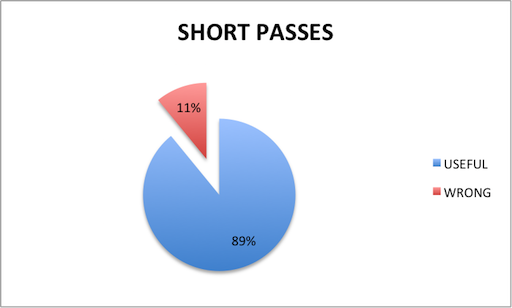
And the distribution of the passes is well spread all over the field:
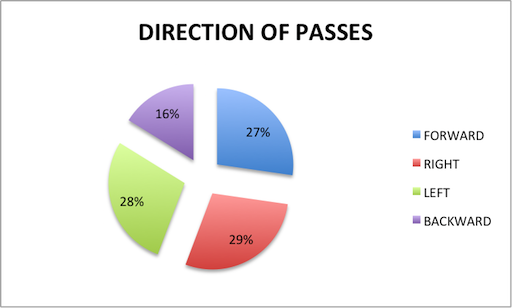
Since the first season at Manchester City, wide wingers are a key factor for the attacking phase and for this reason, long balls (1775 long passes attempts during the 2017/2018 league) are now very important to play through the weak side of the opposition and to create the wide 1 v 1 duels; Sterling and Sanè are involved more than the others. The 40% of wrong long passes demonstrate as they are also forced to find a way to finish the attacking phase on the weak side of the opposition.
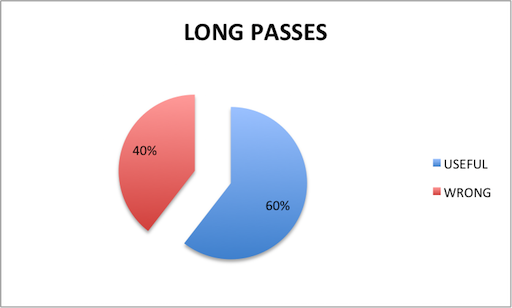
Looking at the goals scored during the league season (106), it's very interesting to notice some common points with Guardiola's Barcelona and Bayern Munich; almost all the goals were scored inside the box, as proof of the search of the maximum depth possible to finish.
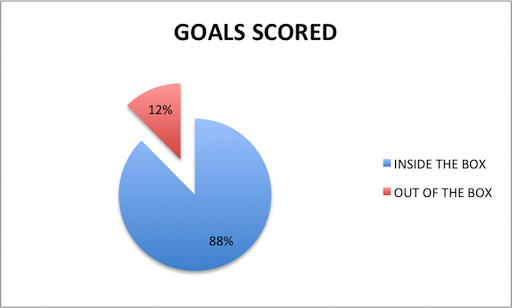
The high percentage of shots on target (52%) demonstrates how City is a highly effective team when the moves can be finished.
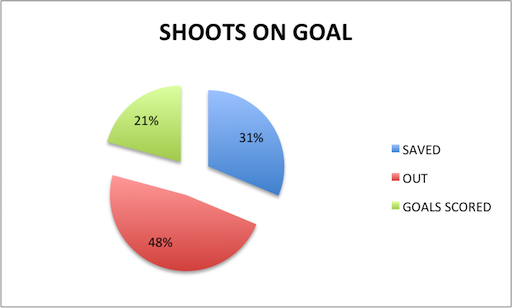
All the shots and the goals are again well distributed from a technical point of view.
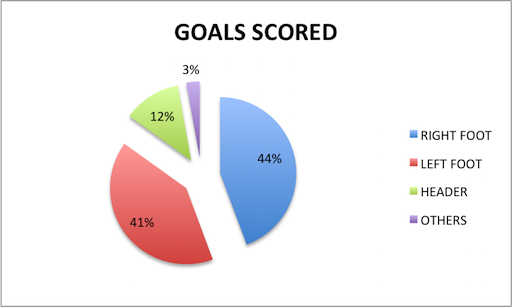
Also the directions of attacks are well distributed all over the final third.
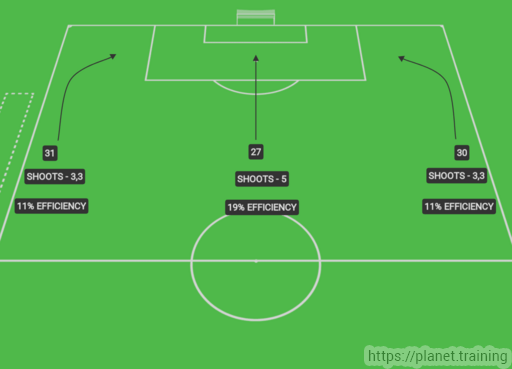
Again, these percentages show that the width of the wingers on the field is used as tool to reach the maximum depth to finish, through the center spaces.
Looking at the directions and at the distribution of the final passes, it's clear again how the maximum depth is the first objective to finish, condensing as many players as possible in the center spaces of the penalty area and around the penalty kick zone, cutting toward the goal from the opposite side to finish inside the second pole zone.
